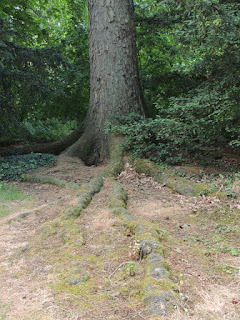As it's December, I was hoping for a festive trunk, but the viruses have been doing the rounds at our house and we haven't been able to get out into the arboretum. Therefore I decided on the Yew, which is not only an interesting trunk (and tree), but is significant to the Christian religion.
This tree is widely planted, sometimes allowed to grow to its full stature, but often as hedging or topiary. Providing a year round cover of leaves, this tree provides hope on the darkest, coldest winter day - hope of life and the return of lush green as spring returns. The trunk is quite flaky, which tends to assist in cleaning the tree of pollution, pests, and disease.
Notoriously difficult to age due to the trunk hollowing out as the tree reaches old age, some Yews are suspected to be around 4000 years old (a trunk girth of more than 4.5 metres). This means that some of the Yews are clearly older than the Christian churches that they are commonly associated with in the UK. This is probably the most mythologised tree in the UK, if not, the world. Why are they grown so often in churchyards? To stop farmers bringing their animals to the churchyard and being poisoned? For making bows? Simply to provide shade? Some of the theories are backed by truth, all parts of the yew, apart from the aril that surround the seed, are poisonous. However, some are clearly false, bows are made from the trunk, not the branches - this would mean the complete removal of the tree - plus this species was never favoured for bow making.
This tree is so flexible, as show with topiary. But naturally it is so too. The image below shows the tree continuing to grow, with what I think are branches that eventually look like a single trunk. New branches seem to appear anywhere on the trunk and tend to grow directly vertical - making for interesting and sometimes unnatural shapes.
The yew is a slow growing tree and not often seen as a commercial timber-producing species. Although when it is used, it is highly valuable. This softwood tree is heavier and harder than the majority of hardwoods.
More importantly, this tree is now used to make Taxol. A chemotherapy drug made from clippings of yew. There is no process to make this entirely synthetically, so live yew material is necessary and therefore there is a market for such clippings.
I've photographed this tree was photographed over a period of years at St Giles in Wiltshire, over that time I've really come to appreciate the beauty of a tree so poisonous. A few years ago, we saw chicken in the woods fungus doing very well on the trunk! This species is edible, but I certainly wouldn't be brave enough with it growing on a yew trunk!
I was happy to see the yew hit the news earlier in the year, when the world famous Fortingall Yew was found with 'berries'. Yew trees are dioecious, meaning that an individual is either male or female, this is common and happens with another very common plant, the holly. However - quite rarely - a branch on a plant can change sex. So a tree that is thousands of years old can surely be forgiven if it fancies a change and provides the beauty of red arils or 'berries'! Read more on that story here.
Thank You:
Firstly a massive thank you to Lucy and Noah for taking me to Westonbirt Arboretum where all the trunks (apart from the yew) were photographed.
Thank you to Westonbirt for providing such an accessible place for me to enjoy these trees. You can learn about this magical place here.
Thank you to Hollis from In the Company of Plants and Rocks and Beth from Plant Postings. They've commented on pretty much every Trunk of the Month, which has helped jolly me along even when (unknown to them) I was iller than normal due to ME during the second half of the year and wanting to give the blog up - even though it brings me joy to write down what I learn about the natural world.
Also, thank you to the trees and, their often epic, trunks. They've captivated me over the past year. I've learnt (and forgotten) so much about them. I'll certainly never look at them in the same way again.
Happy New Year to everyone!
References:
Richard Mabey, 2015. The Cabaret of Plants: Botany and the Imagination. Edition. Profile Books Ltd
Hemery, Gabriel, and Sarah Simblet. The New Sylva: A Discourse of Forest and Orchard Trees for the Twenty-First Century. London: Bloomsbury Publishing, 2014.













































